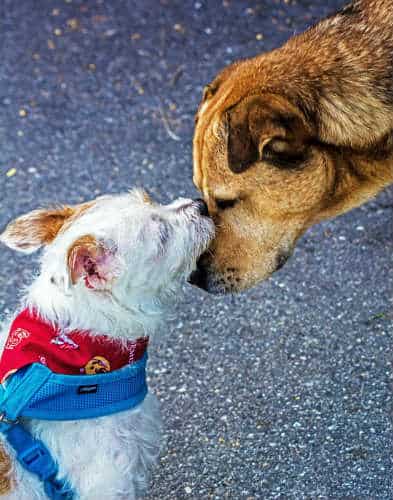Being “in heat” refers to a dog’s estrus cycle or the time when a bitch is receptive to mating.
Heat cycles occur roughly twice a year and can last up to four weeks. During this period, a bitch may undergo and show many physical changes such as vaginal bleeding, frequent urination, personality changes, and a visibly swollen vulva.
Unlike humans, dogs are only fertile and receptive to mating twice a year.
The Heat Cycle Can Include 4 Phases: Proestrus, Estrus, Diestrus, and Anestrus
1. Proestrus

Proestrus is the period before the bitch becomes receptive to mating. The vulva will swell, and bleeding will occur. In some dogs, this bleeding is minimal and barely noticeable. In others, the bleeding will be pronounced enough to stain furniture or otherwise make a mess. You may want to have a diaper for your female dog during this stage to limit the mess. A female is not receptive to mating during proestrus, but males nearby will be interested in her scent and may start trying to enter your yard to gain access.
2. Estrus
Estrus usually sets in within a week to 10 days after the start of proestrus. This is when the dog will be receptive to mating. There will still be a discharge, but it will be watery rather than bloody. A bitch will ovulate during estrus. Most ovulate on day 11 of the cycle and are fertile on days 9 through 13, but individuals will vary and may ovulate earlier or later in this time period.
3. Diestrus
Diestrus is the period that follows successful mating. Dogs carry their litter for approximately 63 days, so successful mating will yield pups within two months of breeding. If the bitch is not pregnant, the diestrus period describes the two months after estrus. You can usually tell when a bitch has entered the diestrus phase when she has stopped having an interest in male dogs and stops being receptive to their advances. You may need to have her checked by a veterinarian to determine whether she’s pregnant.
4. The Anestrus Period
The anestrus period describes the rest of the year when a bitch is not fertile or receptive to mating. During this period, intact males will not be interested or aroused by the bitch. There should be no vaginal discharge during this time; discharge that occurs outside of proestrus may be a sign of a medical condition.
Altogether, the heat cycle will last up to four weeks. There are usually between 50 and 80 days between heat cycles. The individual timeline will vary based on a dog’s age, breed, mating history, health, and individual quirks. If you’re trying to breed your dog, paying attention to her natural cycles and rhythms will help you to better gauge her fertility.
If you’re trying to avoid puppies and unwanted pregnancies, having your pet spayed is the best choice. This saves you the trouble of monitoring heat cycles, reduces the mess, and can protect your pet’s health.
Do Dogs Go Through Menopause?
It may take a few heat cycles for a bitch to become regular. The first couple of heat phases may be longer or shorter than normal or face other issues like failing to ovulate or ovulating on a strange day. In most cases, these cycles will self-correct with time.
Once a bitch has begun having regular heat cycles, she will continue to do so throughout her life. Unlike humans, dogs do not experience menopause. They continue to go through estrus cycles well through old age. However, cycles may become more spread out, and a female’s fertility may wane as ovulation begins to occur on unexpected days. That said, it is not abnormal for a bitch to become pregnant as a senior, and steps should be taken to avoid unwanted pregnancies in dogs that are too old or frail to safely carry a litter to term.
How Often Do Dogs Go Into Heat?
Most dogs go into heat on a biannual basis, with heat cycles occurring approximately every six months. However, this is not universal. Giant dog breeds such as Great Danes and Irish Wolfhounds may go into heat once a year or less. Small breeds and toy breed dogs like Chihuahuas may go into heat more frequently. It’s not uncommon for a small dog to have three or four heat cycles per year.
Because an individual heat cycle can last for up to one month, and heat can happen as often as four times a year, it can feel like a dog is always going into or coming out of heat.
When Will My Dog Have Her First Heat?

Estrus is a sign of sexual maturity, but it often occurs for the first time before a dog is fully grown. A female dog can go into heat as early as 6 months old, but most dogs are not physically mature at this age. At 6 months, some breeds are not yet at their full size, and most are not yet an adult weight. Breeding a bitch at her first heat is likely to put stress on the body if the pregnancy is successful, and not all dogs are likely to conceive during this first heat cycle.
Not every dog will go into heat at 6-months. Some will be 12 months or even 18 months old before the first heat cycle. However, an intact bitch who reaches 2-years of age without ever going into heat should be checked by a veterinarian to rule out any potential medical problems.
Should I Get My Dog Spayed After She Goes Into Heat?
Many people believe that a dog should be allowed to go into heat or be bred once before spaying. The argument is that a bitch who has never experienced heat or motherhood is missing out on an important life experience and may have her personality affected as a result.
However, there is no scientific evidence to support this wive’s tale. Dogs do not seem to have the same opinions about motherhood as humans do, and a female dog is not cognitively equipped to realize that she’s missing out on anything if she never has puppies. More importantly, spaying your pet early can help to prevent many problems such as behavioral issues, unwanted litter, and medical problems.
There is no reason to keep an intact dog you don’t intend to breed. A bitch going into heat twice a year is messy and distressing for both the owner and the dog. Your bitch may be harassed by every dog in the neighborhood, and you will need to watch her constantly to ensure no dogs gain access and impregnate her. Male dogs can be extremely persistent when pursuing a bitch in heat, and even a small window of opportunity can be exploited to create an unwanted pregnancy.
Although aggression is more commonly associated with intact male dogs, female dogs can also see an improvement in behavioral problems after spaying. Because they do not experience hormonal fluctuations and heat cycle stress, spayed dogs tend to have more even-tempered personalities.
The hormone fluctuations associated with estrus can cause problems for a dog whether or not she is bred during her life. Unspayed females are at a higher risk for certain forms of cancer, especially uterine and ovarian cancers, and they can also contract a uterine infection called pyometra. Intact dogs live, on average, shorter lifespans than dogs that have been spayed.
How to Keep a Dog From Going into Heat
Spaying is the most effective and common form of canine birth control. Spay surgery involves the complete removal of a dog’s ovaries and uterus. This makes pregnancy impossible and eliminates the hormone fluctuations associated with going into heat. It is a permanent solution and one of the most routine veterinary procedures.

It’s recommended that a dog be spayed before her first heat for the best results, but the procedure can be performed at any age. It’s also possible to spay a pregnant dog, which will abort the developing puppies. This is a somewhat riskier procedure and is not recommended except in extreme circumstances.
Although spaying is the most common form of canine birth control, other options are available. Veterinarian-prescribed birth control pills can be administered to postpone a dog’s heat cycle. The drug is called Megestrol, which increases the progesterone level in the dog’s body. It must be administered for eight days at the beginning of the heat cycle. The pills must be administered at the same time each day in order to be effective.
Another oral contraceptive option is Mibolerone, which is taken daily rather than at the start of a heat cycle. Mibolerone reduces estrogen levels rather than raising progesterone. The medication is liquid rather than in pill form, and a missed dose can cause the dog to go into heat immediately, so keeping to a strict schedule is essential.
Canine oral contraceptives are most useful in situations where you may breed a dog in the future but wish to avoid a pregnancy at this time. They can also be useful if your dog is sensitive to anesthesia or has another health reason to avoid a spay surgery. However, these medications can be costly, and keeping track of the dosage can be complicated. Whenever possible, surgical sterilization will always be the most effective long-term form of preventing heat in dogs.
